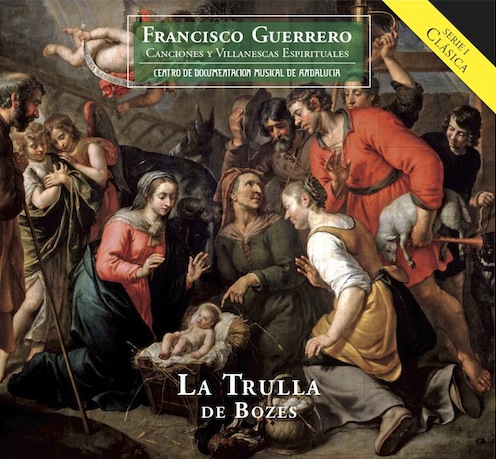Francisco Guerrero
Detail DS-1043 You can buy this record here 11 € Francisco Guerrero Canciones y Villanescas Espirituales
Francisco Guerrero
Canciones y villanescas espirituales
LA TRULLA DE BOZES
01 – Hombres Victoria 2’24
02 – De dondes 1’52
03 – Niño Dios 2’23
04 – Claros y hermanos 3’05
05 – La tierra 2’49
06 – A un niño 5’00
07 - Acaba de matarme 3’04
08 – Juicios sobre 3’30
09 – Mi ofensas 5’09
10 – Virgen sancta 3’59
11 – O celestial medicina 2’25
12 – Al resplandor 4’43
13 – O que mesa 2’48
14 – Apuestan 2’52
15 – Sabes lo 6’05
16 – O virgen 2’09
17 – Zagales sin seso vengo 2’03
18 – Quando’s miro 4’21
19 – Los Reyos 3’08
|
About The Royal and Imperial city of Sevilla
“Sálveos Dios la gran Sevilla, / mar de todos los placeres, / refugio de mercaderes,/ joya del Rey de Castilla,/ lábreos fama rica silla/ de marfil./ Pues poetas y otros mil,/ como vuestra fama es tanta/ dejan a Roma la santa / por Sevilla la gentil”.
God save the great Sevilla / sea of all pleasures / refuge of merchants, / jewel of the King of Castilla, / may fame carve you a rich throne / made of ivory / since poets and a thousand others / being your glory such / leave the holy Rome / for the gentile Seville.
The poet and dramatist Bartolomé Torres Naharro, who was well acquainted with Rome in the time of Pope Leon X, expressed these words in praise of Seville. This city was the birthplace of Francisco Guerrero, who was born on October 4th, 1528, to the painter Gonzalo Sánchez Guerrero and Leonor de Burgos.
At that time Seville was a large, cosmopolitan city. Its vitality was stimulated by the constantly growing trade that attracted people from many different countries and social positions. They brought with them different customs, and new ways of thinking and entertaining. Within this metropolis of West Indian trade a colossal Gothic temple was constructed in order to host the most powerful ecclesiastic institution of the city.
Some of the most remarkable personalities of Seville’s Christian humanist movement were actively involved in the Cathedral. Such figures include Pedro Núñez Delgado, who inherited the Chair of humanities from Antonio de Nebrija; the Protonotary Apostolic Rodrigo de Santaella, founder of the University of Sevilla, and the clerk Diego López de Cortegana, who was the first Spaniard to translate the works of Erasmus. They all belonged to the ecclesiastical elite that sponsored the musical activities of the composer Guerrero.
Seville was also home to Castillian nobles, heirs to the greatest titles and fortunes of the Crown of Castilla, who generously sponsored literature and the arts. In his Historia de Sevilla (c. 1530), Luis de Peraza writes that the city contained some “thirty-two houses or magnificent palaces that in another city would be considered as a Royal Palace”. The owners of these houses included the Duke of Medina-Sidonia, the Duke of Arcos, the Duke of Béjar, and the Marquis of Tarifa. Such noblemen kept musicians at their service.
A Gallery of Portraits of Sevillian Artists Francisco Guerrero received his first music lessons from his brother Pedro, who “helped [Guerrero] to learn very fast because of his knowledge and discipline, so that after a few years, with my great will to learn and my talent for this art, I was able to give him some satisfaction”. He completed his training at the Cathedral initially as a boy-soprano, and finally as a counter-tenor. In his youth he mastered the vihuela, harp, cornetto, and “some other instruments”, as explained by Francisco Pacheco in his Libro de descripción de verdaderos retratos de ilustres y memorables varones (1599).
The young Guerrero studied with Cristóbal de Morales, who possibly assisted him in obtaining his first employment at the age of eighteen as Chapel Master at the Cathedral of Jaén.
After a short period of three years in Jaén, Guerrero established his residence in Seville, where he was part of a remarkable musical environment. Here he met the vihuela players Miguel de Fuenllana (who served at the house of the Marquis of Tarifa) and Alonso Mudarra (clerk of the Sevillian cathedral); the composers Juan Vázquez, Rodrigo de Ceballos and Alonso Lobo; and the organists Diego del Castillo, Gerónimo Peraza and Franciso Peraza. It seems likely that he was involved in the many social gatherings organized by various artists and writers. The cultural life of the city was a prominent topic of discussion at these gatherings, which were hosted by cultivated men and aristocrats. Participants included humanists, clerks, writers and painters, who made up the intellectual and artistic elite of the city, as well as the musicians whose lives Pacheco describes in his Libro de Retratos: Francisco Guerrero, Francisco Peraza and vihuela players Pedro de Madrid and Manuel Rodriguez.
Gutierre de Cetina and Baltasar de Alcázar, who contributed texts for the works in Spanish by Guerrero, also belonged to these literary circles. The composer’s contact with these writers is clearly defined by Pacheco, who writes that Baltasar de Alcázar “was very skilled in music and composed a few madrigals that master Guerrero played with great pleasure and held in high estimation. They were close friends in music and poetry… he composed many songs and other works, as he told me himself, and then he showed them to his friend Gutierre de Cetina”. Juan Ruiz Jiménez Translation: Amy Power & María Martínez Ayerza
|

